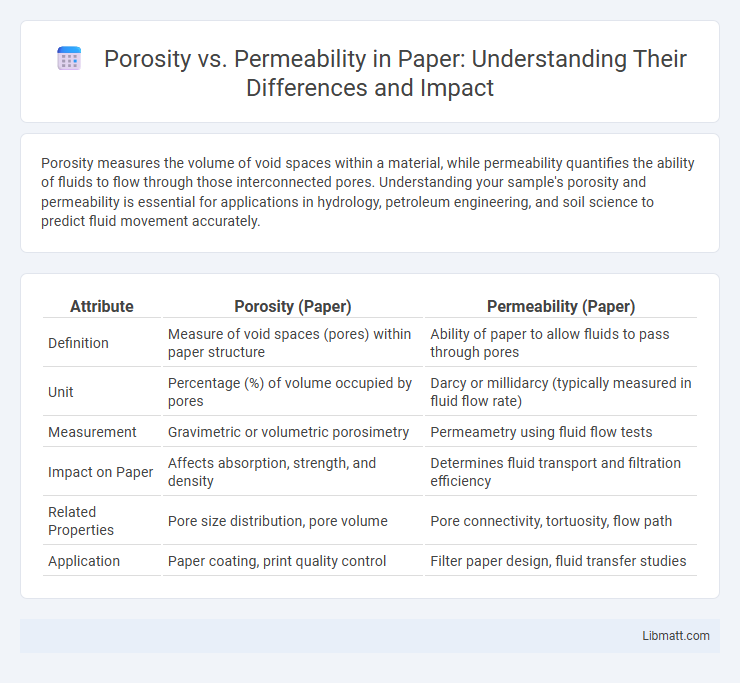Porosity measures the volume of void spaces within a material, while permeability quantifies the ability of fluids to flow through those interconnected pores. Understanding your sample's porosity and permeability is essential for applications in hydrology, petroleum engineering, and soil science to predict fluid movement accurately.
Table of Comparison
| Attribute | Porosity (Paper) | Permeability (Paper) |
|---|---|---|
| Definition | Measure of void spaces (pores) within paper structure | Ability of paper to allow fluids to pass through pores |
| Unit | Percentage (%) of volume occupied by pores | Darcy or millidarcy (typically measured in fluid flow rate) |
| Measurement | Gravimetric or volumetric porosimetry | Permeametry using fluid flow tests |
| Impact on Paper | Affects absorption, strength, and density | Determines fluid transport and filtration efficiency |
| Related Properties | Pore size distribution, pore volume | Pore connectivity, tortuosity, flow path |
| Application | Paper coating, print quality control | Filter paper design, fluid transfer studies |
Introduction to Porosity and Permeability
Porosity and permeability are fundamental properties that define the capacity of a material, especially rocks or soils, to store and transmit fluids. Porosity measures the total void volume within a material, indicating how much fluid it can hold, while permeability quantifies the ability of fluids to flow through interconnected pores. Understanding the balance between porosity and permeability is crucial for optimizing fluid extraction in petroleum engineering, groundwater management, and environmental studies involving your targeted geological formations.
Defining Porosity: Concepts and Types
Porosity refers to the measure of void spaces within a material, expressed as a percentage of the total volume, and is a critical parameter in evaluating reservoir quality in geology and petroleum engineering. It encompasses different types, including primary porosity formed during sediment deposition and secondary porosity created by subsequent geological processes such as fracturing or dissolution. Understanding the distribution and characteristics of these porosity types is essential for accurately predicting fluid storage capacity and flow behavior in porous media.
Understanding Permeability in Materials
Permeability in materials quantifies the ability of a porous structure to allow fluids to flow through interconnected voids, directly influenced by pore size, shape, and connectivity rather than just porosity percentage. Unlike porosity, which measures the volume fraction of void spaces, permeability depends on how these voids are interconnected, determining fluid transport efficiency in materials such as rocks, soils, and ceramics. Accurate assessment of permeability is essential in fields like hydrogeology, petroleum engineering, and material science for predicting fluid movement and optimizing extraction or filtration processes.
Key Differences Between Porosity and Permeability
Porosity measures the volume of void spaces within a rock or sediment, indicating how much fluid it can store, while permeability assesses the ability of those fluids to flow through the interconnected pore spaces. Higher porosity does not always guarantee higher permeability because pore connectivity and size also influence fluid movement. Understanding these key differences helps you evaluate reservoir quality and fluid extraction efficiency in geological and engineering applications.
Measurement Techniques for Porosity
Porosity measurement techniques include mercury intrusion porosimetry, gas adsorption, and nuclear magnetic resonance (NMR), each providing detailed quantification of pore volume and size distribution within paper substrates. These methods determine porosity by assessing how much fluid or gas a paper sample can absorb or retain under controlled conditions, critical for applications involving filtration or ink absorption. Accurate porosity data helps optimize your paper's performance by tailoring its structural properties to specific industrial or printing requirements.
Methods for Assessing Permeability
Permeability assessment methods in geological studies often involve steady-state and unsteady-state flow techniques, such as constant head and falling head permeability tests, to quantify fluid flow through porous media. Laboratory approaches, including core analysis with gas or liquid permeameters, provide detailed permeability measurements under controlled conditions. Advanced imaging methods like micro-CT scanning offer non-destructive evaluation of pore connectivity and structure, enhancing the understanding of permeability beyond traditional permeability-porosity relationships.
Factors Affecting Porosity and Permeability
Factors affecting porosity and permeability in paper include fiber type, fiber bonding, and sheet density. The arrangement and compaction of fibers influence void spaces, directly impacting porosity, while pore size and connectivity control permeability. Understanding these factors helps you optimize paper characteristics for specific filtration or absorption applications.
Role in Hydrogeology and Petroleum Engineering
Porosity measures the volume of void spaces in rock, determining its capacity to store fluids, while permeability quantifies the ability of those fluids to flow through the rock's pore network. In hydrogeology, high porosity combined with high permeability facilitates efficient groundwater flow and aquifer recharge. Petroleum engineering relies heavily on permeability to assess reservoir quality and optimize hydrocarbon extraction, with porosity providing the storage capacity but permeability controlling fluid movement.
Real-World Applications: Case Studies
Porosity and permeability are critical parameters in evaluating reservoir quality and fluid flow in hydrocarbon exploration, groundwater management, and soil science. Case studies from the North Sea oil fields demonstrate how high porosity does not always correlate with high permeability, affecting extraction strategies and recovery rates. Understanding these relationships allows you to optimize well placement and enhance resource management in diverse geological settings.
Conclusion: Implications for Research and Industry
Porosity determines the storage capacity of a reservoir rock, while permeability controls the ease of fluid flow, making both critical parameters in hydrogeology and petroleum engineering. Precise characterization of these properties improves reservoir management, enhancing extraction efficiency and reducing environmental risks. Your understanding of porosity and permeability relationships drives innovation in exploration techniques and informs sustainable resource development strategies.
Porosity vs permeability (paper) Infographic

 libmatt.com
libmatt.com